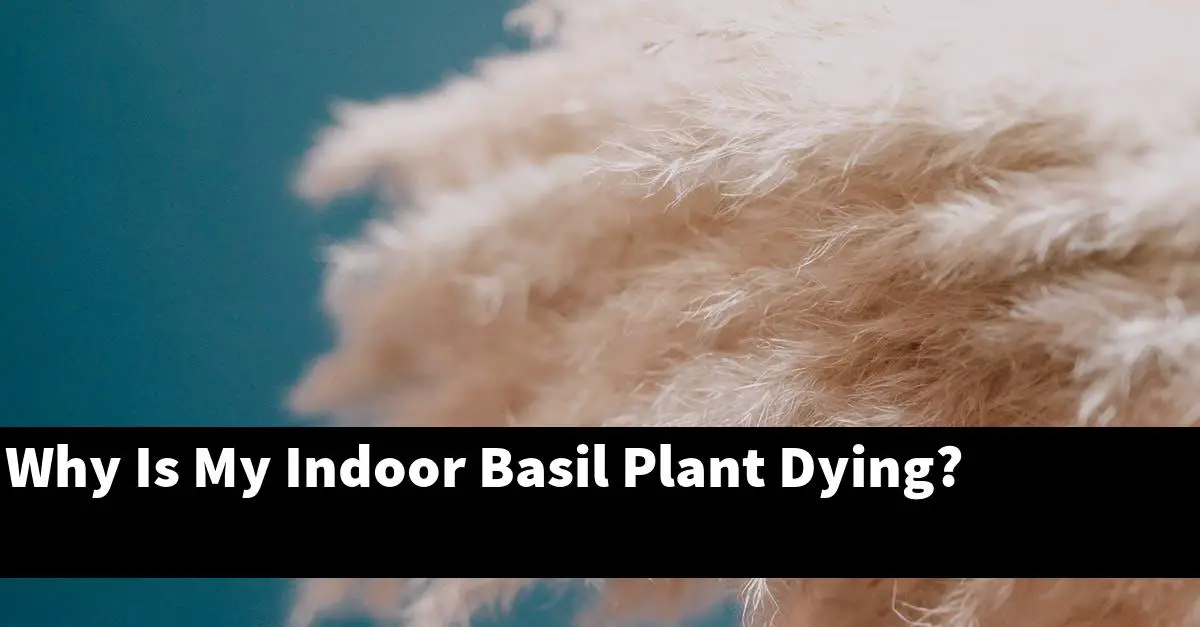Basil (Ocimum basilicum) is a popular herb that is often grown indoors. However, basil plants can be difficult to care for, and many people find that their indoor basil plants die.
There are a number of reasons why this may happen, including incorrect watering, poor drainage, and lack of sunlight.
How do you care for a basil plant indoors?
There are a few things that you will need in order to care for a basil plant indoors. First, you will need a pot that is large enough for the plant to grow in, but not too large.
You should also provide the plant with plenty of water and fertiliser. You should also keep the plant away from direct sunlight, as this can cause the leaves to turn brown.
How do you revive a dying basil plant?
There are a few ways to revive a dying basil plant. One option is to water the plant thoroughly and give it a good fertilization.
Another option is to replant the basil into a fresh container. If the basil is severely dying, you may need to remove the plant and start over.
Why is my basil dying inside?
There could be a number of reasons why your basil is dying inside. One possibility is that the basil is overwatering itself.
Overwatering can cause root rot and the death of basil plants. Basil plants need water in order to keep their leaves and flowers moist, but too much water can lead to over-hydration and root rot.
Another possibility is that the basil plant is not getting enough light. If your basil plant is not getting enough light, it will not be able to produce energy needed to grow and will eventually die.
Finally, basil plants can also die from viruses or other diseases. If you notice that your basil plant is dying suddenly, it might be a good idea to get it checked out by a professional.
What does overwatered basil look like?
Overwatered basil looks like wilted, leggy plants with drooping leaves and stems. The leaves may also be relatively dry, brown, and leathery.
Overwatering may also lead to fungal overgrowth and reduced yields.
Why is my basil dying?
There are a few potential reasons why basil may be dying. One possibility is that it is losing water due to a shortage or a broken water line.
Another possibility is that there is too much water in the soil, and the basil is drowning. Finally, the basil may be experiencing a fungal or bacterial infection.
If you notice that your basil is wilting or dying, it is important to investigate the root cause and take appropriate action.
Is my basil plant dead?
If you observe that your basil plant is wilting or dying, there is a high chance that it is dead. It is important to remember that basil plants can go through a dry period where the leaves may yellow and curl, but this is not indicative of a dead plant.
If you notice that the plant is emitting a foul odor, it is also likely dead. In either case, it is important to remove the plant and take it to a garden center for proper diagnosis.
How to save dying basil plant?
If your basil plant is showing any of the following signs, it may be time to start thinking about saving it:
-Leaves droop and are limp
-Vines are wilting or have died
-Plants have a yellowing or browning of their leaves
-Fruit is not forming or is small and shriveled
There are a few things that can be done to save a dying basil plant. First, try to give the plant as much water and fertilizer as possible.
If the plant is getting a lot of light, try to move it to a darker location. If the plant is poorly rooted, try to help it root in some water.
If all else fails, you can take the plant down and replant it.
What is wrong with my basil plant?
There could be a few things wrong with your basil plant. The most common problem is that the basil plant is not getting enough sunlight.
If the basil plant is not getting enough sunlight, the leaves will become yellow and the plant will not be able to produce much of its own energy. Basil also needs to be kept watered regularly; if it is not, the leaves will turn brown and the plant will not be able to grow.
What happens if you fertilize basil too much?
Sometimes people fertilize basil too much, which can cause the plant to grow too quickly and may lead to problems. Too much fertilization can cause the plant to grow too many leaves and flowers, which can make it susceptible to pests and diseases.
Fertilizing basil too much can also cause the plant to produce too much sap, which can damage the plant’s roots.
What happens to basil when it freezes?
Basil can freeze quite well and will keep in a freezer for up to 6 months. When frozen, the leaves will become brittle and the stem will snap if bent.
The stem can also become brittle and break off from the plant. The leaves will become quite stiff and will not snap when bent.
Why is my basil not growing in my pot?
Basil is a bushy, slow-growing herb that does best in a well-drained soil with a neutral pH. Basil does not do well in high humidity environments or in soils that are too acidic. Basil can also be propagated from cuttings taken from a healthy plant.
Conclusion
There are several possible reasons for an indoor basil plant to die. Some common causes include too little light, too much water, or pests.
If the plant is not getting enough light, it will become leggy and yellow. Too much water can cause the roots to rot, and pests can damage the leaves and stems.

